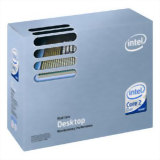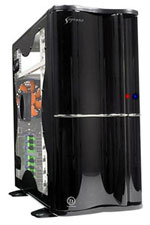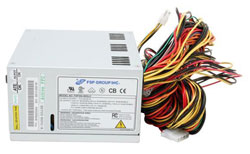Upgraded Intel Midrange Platform
If we had to choose one system as an overall recommendation today, it would have to be this upgraded Core 2 Duo configuration. There are almost no compromises made, and without spending significantly more money it will be difficult to improve performance. As usual, the one exception is gaming, where a faster, more expensive GPU is almost always a possibility. Below is our upgraded Intel recommendation.
 |
As with the AMD platform, our upgraded Intel system has moved up one rung on the performance ladder. Moving from the E6300 to the E6400 represents a 14% CPU speed increase, and it comes with a 23% price increase. Bang for the buck is actually better than the AMD upgrade, but there are other advantages as well. The base clock speed is now 2.13 GHz with an 8X multiplier. Clock speeds of beyond 3 GHz should now be achievable, with a 400 MHz front side bus equating to a 3.2 GHz CPU. Even without overclocking, the E6400 is no slouch, generally offering performance that falls somewhere between that of the Athlon X2 4600+ and 5000+. With overclocking, the E6400 at 3.0 GHz appears to be out of reach of anything AMD can offer with their current architecture and process technology, all at a price of about $225.
You could upgrade to 4MB of cache and 2.4 GHz for another $90 if you so desire, and there are various reasons to do so. The increased clock speed will improve performance about 12%, and the larger L2 cache will on average add another 5% to performance - assuming nothing else is your bottleneck - for a total speed increase of about 18%. The price increase is 41% however, so you are essentially getting 1-for-2 performance scaling. If you are more concerned with CPU performance, the E6600 is a nice upgrade; for gamers you would be much better off spending the money on a faster GPU.
 |
For the upgraded configuration, we still couldn't go with a super high-end motherboard, but we did upgrade to a motherboard that should offer some great overclocking potential. The Gigabyte GA-965P-S3 first showed up in our labs as a pretty mediocre offering, but with the latest BIOS updates it has turned into a real gem. The Gigabyte DS3 will still overclock a bit better in terms of maximum bus speed, but you're much more likely to run into the limitations of your memory and/or processor first. 400 MHz bus speeds are easily achievable on the S3, and a 3.2 GHz Core 2 Duo processor is extremely fast. Note that you do only get a single X16 graphics slot, so if you want more gaming performance you will have to resort to something like the 7950 GX2 cards or wait for faster models to arrive on the market.
Again, we've already looked at the memory and video card options with the upgraded AMD configuration, so let's move on to the storage and other components. We stuck with the NEC ND-3550A DVD-RW drive for all of the reasons we listed previously and we also kept the same mouse, keyboard, and operating system to keep things simple. On the hard drive, we make the upgrade to a slightly larger 320GB model that supports 16MB of cache and comes with a five year warranty from Seagate. Western Digital, Samsung, Maxtor, and Hitachi are again competitive with slightly varying features and performance.
 |
Where we made a big change over the baseline configuration is the choice of case and power supply. Opinions on cases are going to vary widely from person to person. What one person thinks looks awesome another person is going to think looks garish; slick and sleek for us might be dull and boring for you. The Thermaltake Soprano is a nice looking case, at least in our opinion, and you get two 120mm fans that provide a good amount of air flow without creating a ton of noise. The case also features a mostly tool-less design, and you can get it with or without a side window. If you don't like the case that we picked, by all means go out and select a case that you do like. Sticking with the baseline case is certainly an option to save money, although the power supply is a different matter.
 |
While we still haven't created a configuration that really needs an extremely high-end power supply, if you are going to spend money for a quality aftermarket power supply there's no reason to save $10-$15 and miss out on some features that might prove useful in the long run. Fotron Source is one of the most well-regarded power supply manufacturers, and several well-known power supply providers basically offer rebranded Fotron Source PSUs. We did have to draw the line somewhere, so you won't see is recommending $150+ power supplies for a midrange computer. We ended up settling on the 550W SLI ready FSP550-80GLC, which offers plenty of power, relatively silent operation, and it's ready for multiple graphics cards should you ever decide to take that step.
If you only intend to run a single GPU and you aren't going to overclock, many of our upgrade options could easily be changed. The RAM in particular was chosen to really allow some overclocking headroom, but you could stick with the cheaper RAM and instead simply buy a faster CPU. Getting a good quality PSU is rarely a bad decision, but for non-overclockers you can stick with a bundled PSU of around 400W and you shouldn't have problems. In the end, we are limited in the number of configurations we can list due to time constraints, but by all means feel free to ask or comment on the component choices, as there is no "one size fits all" computer system.














49 Comments
View All Comments
JarredWalton - Wednesday, September 27, 2006 - link
1600x1200 is nice, but it's about the same total pixel number as 1680x1050 (a bit more) and it costs more. I would personally take the Acer 22" WS over 1600x1200 - widescreen looks awesome. If you prefer not to have to deal with getting WS resolutions to work, though, 1600x1200 is probably the best way to go for LCDs.Revolutionary - Wednesday, September 27, 2006 - link
Having just built a system based on the 965P-S3, I want to make 2 comments:First, OCZ Platinum 6400 DOES NOT WORK in this motherboard. Its a known conflict not fixed by the F4 Bios. Do some searching in the forums and on Google.
As for the difference between the S3 and the DS3: the singular difference is solid-state vs. fluid capacitors. There is no difference in overclocking performance; the solid state capacitors have a longer life-expectancy. Not even Gigabyte claims that the DS3 will OC better. Again, Google around a bit to see for yourself.
JarredWalton - Wednesday, September 27, 2006 - link
I have talked with to Gary Key, and the following is information from him as well as my own comments:The DS3 is doing around 510 in our testing, while we got around 460 stable on the S3. We've seen reports of up to 480 on it. The caps make a huge difference in overclocking as they run cooler, allowing higher clocks and additional stability.
And he has had no issues with running the OCZ Platinum Rev. 2 DDR2-800. There is a big difference between RAM not working, and RAM not working when you simply run everything at default settings. The OCZ RAM does like more voltage than stock. It is rated at 4-4-4-15 2.2V DDR2-800, and while it may run fine at 1.8V 4-4-4-15 in some circumstances, it is designed to run with higher voltages.
Unfortunately, just doing a Google on information doesn't mean the information is accurate. Any monkey with a keyboard and an internet connection can post content to the internet, but we don't know if they really have a clue what they're doing. A beginner that can't get OCZ + S3 to run properly because they assume "Auto/SPD" should just work fine will blast both products. High-end enthusiast RAM often requires special considerations like bumping the voltage level up to 2.0-2.2V. We even posted appropriate settings, though:
"The OCZ 2x1024MB PC2-6400 Platinum Revision 2 ran at 4-4-3-10 with 2.2V at up to DDR2-900, 5-4-4-12 at DDR2-1000 with 2.3V, and topped out at about DDR2-1033 at 5-5-5-12 with 2.3V."
And the OCZ RAM is generally out of stock right now. You can try the G.Skill RAM which performs about the same. It costs a bit more, however:
http://www.newegg.com/Product/Product.asp?Item=N82...">G.Skill DDR2-800 Note that the G.Skill will also require more voltage than 1.8V (or even 1.9V), and in testing it will generally run about the same as the OCZ Platinum 2.
Sunrise089 - Tuesday, September 26, 2006 - link
Although the Anandtech forums can be usefull for this sort of info, I always enjoy seeing a new system price guide, and find them one of the most usefull parts of the site. I'm not sure how sustainable one guide every two weeks will be (are you guys going to stop making the individual part guides since system guides will come out so often?) but if you can make it work then great. One thing I would love to see however is budget, midrange, high-end, and overclocking guides. I think the fourth category has at least as many followers as the high-end segment, and it might make your midrance guide quicker to write, since you could ignore overclocking performance.JarredWalton - Tuesday, September 26, 2006 - link
I find it difficult *not* to talk about OC'ing, but I suppose I could try and then move that into a separate guide. Hmmm.... If we have the price guides up and running again, I may cut it down a bit, but for now system component prices are changing enough that every other week is pretty sustainable.Sunrise089 - Wednesday, September 27, 2006 - link
One of the specific reasons I would prefer a seperate OC'ing guide is because while I might build a PC exactly as described in the midrange guide if I were building it for a family member, I would have to make several additional decisions if I were buying it for myself and wanted to overclock. In an overclocking PC I would want to add an aftermarket HSF, maybe consider a different PSU, and be much more interested in specific OC'ing performance in the memory and motherboard. Although it's nice to see that at X23800+ or a Core2Duo6600 can overclock, if the guide doesn't tell me what additional choices I need to make in order to take advantage of the overclocking headroom then it isn't really serving as a "buyer's guide" to the overclocking user. Therefore it seems a good idea to me to add the specific guide for overclocking in order to allow for overclocking specific reccomendations.yacoub - Tuesday, September 26, 2006 - link
Most of us can do a LOT better for the money because we won't need to buy a new case, keyboard, mouse, display, harddrive, optical dive, etc. Most folks will only need to upgrade the motherboard, RAM, and CPU. Some also their GPU.So if you estimate $200 for a CPU, $200 for a motherboard, and $250 for RAM, you're looking at under $700 for an upgrade to the latest and greatest.
Murst - Tuesday, September 26, 2006 - link
I think you miss the point of this review.Chances are, if you're upgrading your system, then yes, you will be upgrading certain parts. However, even if you're upgrading certain parts, your post seems rather strange. Most people will probably consider upgrading the gfx card before upgrading the cpu/mb/ram. Also, if you upgrade your mb, chances are that it is not pci-e so you will have to upgrade your sound card as well. But I guess that all depends on how often you upgrade (I'm thinking of a 2 year cycle from what I do)
But anyways, this review is about what type of system you can build for 1-1.5k. It is not about what part Joe can put into his own computer to make it faster, althogh some of us certainly look at their recomendations when we do choose to upgrade specific parts.
yacoub - Tuesday, September 26, 2006 - link
I guess you missed my point. I wasn't critiquing the review, just adding a note related to it. A lot of folks probably run s939 boards right now, and may have even already picked up a cheap X2 dual-core CPU recently so they are obviously going to focus their next upgrade on GPU.Other folks here are running s754 or similar generation Intel setups that were 1st gen PCI-E and not dual-core compatible, and probably have recently upgraded to a good GPU but are looking to upgrade their system core (cpu, mobo, and RAM) soon since that will be significant for them.
The second group is who I was talking about.
As far as audio cards, my X-Plosion 7.1 DTS should work fine for a while, as most boards have at least one PCI slot.
RamIt - Tuesday, September 26, 2006 - link
"The Gigabyte GA-965P-S3 first showed up in our labs as a pretty mediocre offering, but with the latest BIOS updates it has turned into a real gem. The Gigabyte DS3 will still overclock a bit better in terms of maximum bus speed"What gives? The s3 and the ds3 are the basicly the same motherboard with almost identical bioses with the exclusion of the caps. How could the ds3 clock better than the s3?